Porphyrellus E.-J. Gilbert
The only European member of this genus is instantly and easily recognized due to its specific colours, dark coloured pores and purple-brown spore-print.
Porphyrellus porphyrosporus (Fr. & Hök) E.-J. Gilbert
Description
Cap up to 10 cm, at first hemispherical then expanding to convex, beige, pale brown to dark brown, velvety. Stipe cylindrical or club-shaped, almost concolorous with the cap, often paler in the lower part. Flesh white, flushing vinaceous and bluish green when exposed to air, then darkening. Tubes at first whitish, then darkening. Pores greyish brown to brown. Smell not distinctive or somewhat acidulous. Taste unpleasant. Spores 12–18 × 5.5–7.5 μm.
Habitat. Coniferous, mixed and deciduous forests, mycorrhizal with spruce (Picea), pines (Pinus), beech (Fagus), oaks (Quercus) or lime (Tilia).
Distribution. Widespread throughout Europe.
Photographs
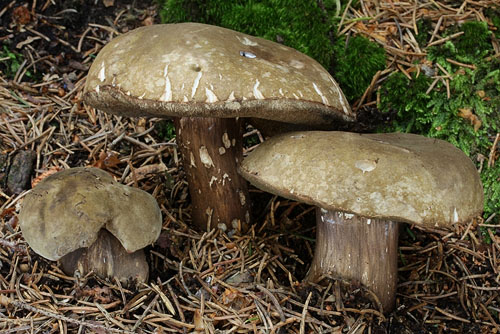
Typical fruitbodies of Porphyrellus porphyrosporus. (photo M. Mikšík)
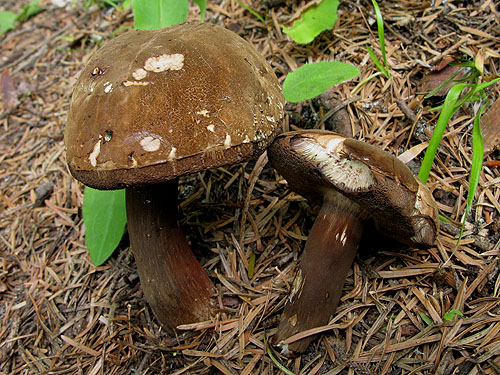
Fruitbodies of Porphyrellus porphyrosporus. (photo I. Assyova)
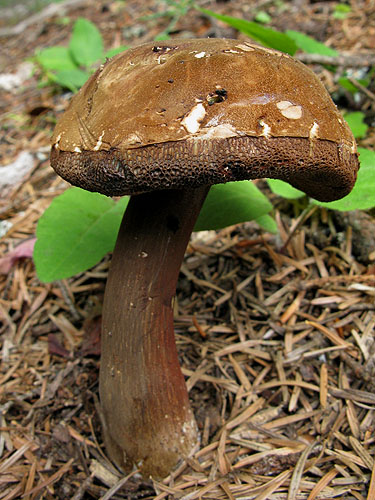
Fruitbody of Porphyrellus porphyrosporus. Note the dark coloured pores. (photo B. Assyov)
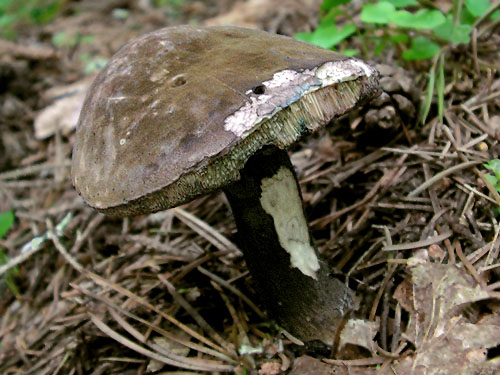
Fruitbody of Porphyrellus porphyrosporus. Faint blueing is seen on the tubes and the cap flesh where injured. (photo I. Assyova)
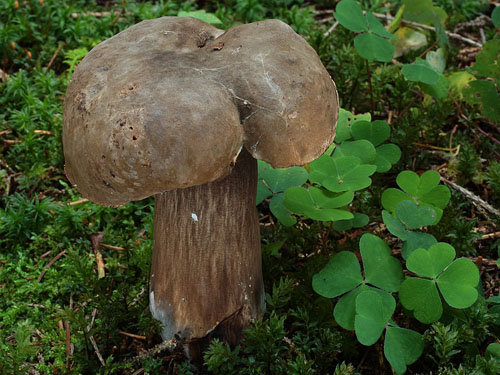
Fruitbody of Porphyrellus porphyrosporus. (photo M. Mikšík)

Fruitbodies of Porphyrellus porphyrosporus. (photo V. Zanev)
Important literature
Alessio, C.L. 1985. Boletus Dill. ex L. (sensu lato). – In: Fungi Europaei. Vol. 2. Pp. 1–705. Libreria editrice Biella Giovanna, Saronno.
Breitenbach J. & Kränzlin F. 1991. Pilze der Schweiz. Bd. 3(1). Röhrlinge und Blätterpilze. Verlag Mykologia, Luzern.
Estadès, A. & Lannoy, G. 2004. Les bolets européens. – Bulletin Mycologique et Botanique Dauphiné-Savoie 44(3): 3–79.
Galli, R. 1998. I Boleti. Atlante pratico-monographico per la determinazione dei boleti. Edinatura, Milano.
Hansen, L. & Knudsen, H. 1992. Nordic Macromycetes. Vol. 2. Polyporales, Boletales, Agaricales, Russulales. Nordsvamp, Copenhagen.
Knudsen, H. & Vesterholt, J. [eds.]. 2008. Funga Nordica. Nordsvamp, Kopenhagen.
Lannoy, G. & Estadès, A. 2001. Les Bolets. Flore mycologique d’Europe. Documents Mycologiques Mémoire Hors série no. 6. Pp. 1–163. Association d’Écologie et de Mycologie, Lille.
Muñoz, J.A. 2005. Boletus s. l. – In: Fungi Europaei. Vol. 1. Pp. 1–951. Edizioni Candusso, Alassio.
Pilát, A. & Dermek, A. 1974. Hríbovité huby. Československé hríbovité a sliziakovité huby (Boletaceae – Gomphidiaceae). Veda, Bratislava.
Singer, R. 1967. Die Röhrlinge. II. Die Boletoideae und Strobilomycetaceae. – In: Die Pilze Mitteleuropas. Vol. 6. Pp. 1–151. Julius Klinkhardt Verlag, Bad Heilbrunn.
Šutara, J., Mikšík, M. & Janda, V. 2009. Hřibovité houby. Čeled’ Boletaceae a rody Gyrodon, Gyroporus, Boletinus a Suillus. Academia, Praha.
Watling, R. 1970. Boletaceae, Gomphidiaceae, Paxillaceae. – In: Henderson, D.M., Orton, P.D. & Watling, R. [eds]. British fungus flora. Agarics and Boleti. Vol. 1. Royal Botanic Garden, Edinburgh.
Watling, R. & Hills, A.E. 2005. Boletes and their allies (revised and enlarged edition). – In: Henderson, D.M., Orton, P.D. & Watling, R. [eds]. British Fungus Flora. Agarics and boleti. Vol. 1. Royal Botanic Garden, Edinburgh.